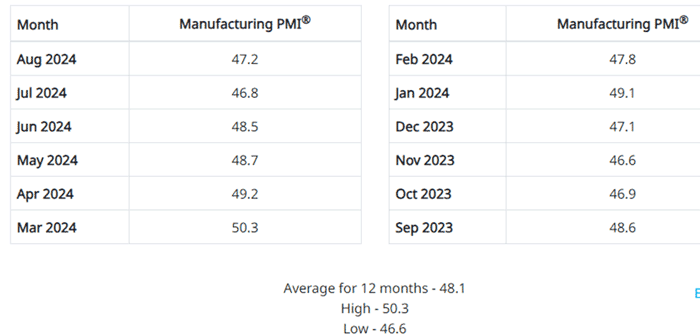The US Purchasing Managers Index (PMI) for August was released Tuesday by the Institute for Supply Management (ISM), and came in at a level of 47.2, up a little from July but again below the key 50 mark that separates US manufacturing expansion from contraction.
The US PMI had previously been in contraction territory for 17 straight months until it poked its head into expansion in March, but has fallen back to contraction now in each of the last five months.
Supply Chain Digest Says... |
 |
|
| Fiore added that “Demand remains subdued, as companies show an unwillingness to invest in capital and inventory due to current federal monetary policy and election uncertainty. Production execution was down compared to July, putting additional pressure on profitability.” |
|
 |
|
What do you say? |
|
| Click here to send us your comments |
|
| |
|
| Click here to see reader feedback |
|
|
|
The overall economy continued in expansion for the 52nd month after one month of contraction in April 2020. The PMI tracks closely but not exactly with the overall US economy.
A Manufacturing PMI above 42.5, over a period of time, generally indicates an expansion of the overall economy, according to ISM.
The other PMI numbers we track were also mostly negative.
That starts with the New Order Index, which remained in contraction territory, registering a score of a weak 44.6, 2.8 percentage points lower than the 47.4 seen in July, in a negative sign for future US manufacturing activity.
The August score of the Production Index was 44.8, 1.1 percentage points lower than July’s figure of 45.9, as manufacturing output once was in contraction status.
The Price Index registered 54.0, up a bit from the July score of 52.9. That means most companies saw a rise in the cost of components, materials and other inputs (below 50 = falling prices), a little more strongly versus the previous month.
The Backlog of Orders Index was at a low level of 43.6 for the month, though up 1.9 percentage points compared to 41.7 in July. That means the order book of most companies is shrinking, with the index level still well below the 50 mark.
The Supplier Deliveries Index remained in “slower” territory, at 50.5, down from 52.6 in July.
Supplier Deliveries is the only ISM index that is inversed, with a reading of above 50 indicating slower deliveries, which is typical as the economy improves and customer demand increases - or the reverse.
In one bit of good news, the Inventories Index came in at a score of 50.3, up 5.8 percentage points from July to move (barely) into expansion territory, with the score above 50 indicating inventory levels at companies are increasing.
Said Timothy Fiore, Chair of the Institute for Supply Management Manufacturing Business Survey Committee: “While still in contraction territory, US manufacturing activity contracted slower compared to last month. Demand continues to be weak, output declined, and inputs stayed accommodative.”
He added that “Demand remains subdued, as companies show an unwillingness to invest in capital and inventory due to current federal monetary policy and election uncertainty. Production execution was down compared to July, putting additional pressure on profitability.”
(See More Below)
|
CATEGORY SPONSOR: SOFTEON |
|
|
|
|
|
As always, the ISM report provides a graphic of the PMI scores the last 12 months, which as can be seen indicates the measure has been below the key 50 for the past year and actually since November 2022, with the exception of March 2024. It is now averaging just 48.1 over the past year.
US PMI Last 12 Months

Source: ISM
Of the 18 sectors tracked by ISM, just four reported growth in August. They are, in order: Paper Products; Primary Metals; Wood Products; and Computer & Electronic Products.
As always, there were some interesting comments from PMI survey respondents.
“High interest rates are curtailing consumer spending on large discretionary spending for furniture, cabinetry, flooring and decorative trim, which has affected our industry sales potential. At the same time, pent-up demand seems to be growing for housing and remodeling. Interest rate cuts may not happen soon enough to have an impact this year,” said one manager in the wood products sector.
“Business is cooling down, and we don’t expect a rebound until after the election is over. As we build our 2025 budget, we continue to have deep concerns about the added environmental costs on energy,” added a respondent in the paper industry.
Finally, a manager in the fabricated metals industry observed that “Our order levels are on a slow, steady decline; it looks like the trend will continue through the end of the year. We are downsizing through attrition and not hiring backfills, but there have been no layoffs to date. The bright spot is a few customer programs have helped increase orders for parts, resulting in some production areas to be very busy while others have little work. Redeploying people where we can.”
What are your thoughts on the August PMI? Let us know your thoughts at the Feedback section below.
Your Comments/Feedback
|

